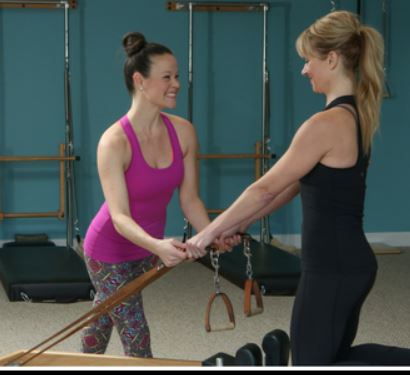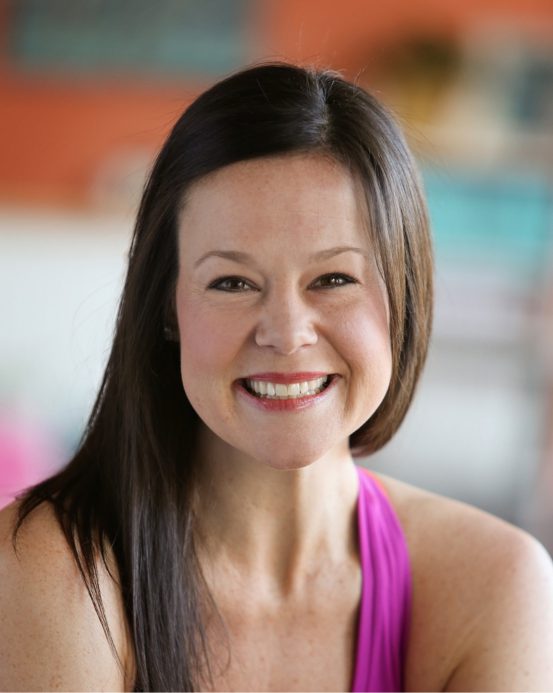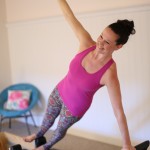Mirror, Mirror, Off The Wall
by Carrie Pages
Mirrors and movement disciplines have always gone hand in hand.
I was a dancer and, for dancers, mirrors are intended to help perfect form and improve technique. I, however, used them to focus on every little imperfection I observed, which ultimately led to an incredibly negative body image. When I walked into the dance studio, I would casually walk the length of the mirrored room and watch my image grow shorter or taller after each connecting seam. I would then decide which was the “skinny mirror” – and that’s how I chose my place at the barre. I’m embarrassed to say that one of my deciding factors in quitting dancing was my inability to reconcile my issues with body image … but it was. So, I quit dancing and started teaching Pilates which, funnily enough, is another industry that relies on mirrors for improving form and technique.
But is that really how we use them?
When I first began teaching Pilates, there were mirrors on 3 of the 4 walls of the studio where I taught. Of course, I had made very little progress with my body image in the one year since quitting dance, but I’m happy to say that with time, those issues did improve. I was always convinced that negatively judging your reflection in the mirror was something only I obsessed over. I quickly realized it wasn’t and that mirrors can be a distraction for anyone.
I remember one client being so distracted by her reflection, that it became a conversation during every session. After rolling up from a beautiful Spine Stretch forward, she’d catch a glimpse of her reflection in the mirror and exclaim how horrible she looked that day. Instead of experiencing the satisfaction of how the exercise felt in her body, her focus was on her appearance.
Another regular conversation with many of my clients, after catching a glimpse of themselves in the mirror, was how awful they looked curling. You probably know this conversation well. We all end up with a double chin when curling, which is essential to eliminating neck strain, but if clients see their reflection, they usually lift their chin up and lose the corrective benefits to their posture. The bottom line was that seeing their reflections was affecting their results as they adjusted themselves from proper from to poor form.
 For me, Pilates is a method of exercise that helps us to perform our daily tasks with spontaneous zest and pleasure! Sound familiar? It’s about being able to stand up with ease after playing on the floor with your grandkids. It’s about being able to jump up and cheer at a football game. It’s about connecting the mind with the body to improve proprioception, so you don’t always have to look down whenever you step up on or off a curb. When we look to the mirror to observe form, we’re often distracted by the look of our skin — the house for the bones of our body. Shouldn’t we instead focus on how the bones inside the body are lined up? Looking in the mirror to see if the ribs are flared or the pelvis is neutral is often interrupted by noticing how our leggings squeeze our waistline.
For me, Pilates is a method of exercise that helps us to perform our daily tasks with spontaneous zest and pleasure! Sound familiar? It’s about being able to stand up with ease after playing on the floor with your grandkids. It’s about being able to jump up and cheer at a football game. It’s about connecting the mind with the body to improve proprioception, so you don’t always have to look down whenever you step up on or off a curb. When we look to the mirror to observe form, we’re often distracted by the look of our skin — the house for the bones of our body. Shouldn’t we instead focus on how the bones inside the body are lined up? Looking in the mirror to see if the ribs are flared or the pelvis is neutral is often interrupted by noticing how our leggings squeeze our waistline.
When I opened my studio in 2002, I decided against installing mirrors. While I realize this may be me projecting my issues on those without them, it was important to me to give my clients the experience of feeling Pilates in their bodies, rather than seeing physical results. Fifteen years later, I’m still happy with that decision. The last thing I want my clients to feel during an awesome workout is disappointment in what they see in the mirror. I want them to feel strong, connected, fit and tall, and I want that feeling to carry over as they walk out the door.
There are times I would love to have a mirror in the studio! It’s a great tool for when a client can’t feel what they’re doing and you’ve corrected their form 5 times saying the same thing 5 different ways. While that can be so frustrating, in those situations I fall back on my faith in The Method. Pilates is a process. Even if a movement looks just right from the outside, our internal body always has somewhere to go. As an instructor, it’s my job to teach my clients the exercises and keep a close eye on how they’re executing them. More importantly, it’s my job to empower them with positive feedback, which helps them do the same for themselves over time.
I’m in no way saying take the mirrors down. I just wanted to start a conversation about what you’re really looking for in the mirror. Is it possible that mirrors distract from the full benefits of Pilates? Consider turning your clients’ backs to the mirror every once in a while. Or find a spot in the studio where there’s no mirror at all. Encourage your students to observe how the exercise feels. What does sitting up tall feel like? What does moving from an anterior tilt to neutral pelvis when standing feel like? It’s possible your clients will gain a new appreciation for how to do Pilates inside and outside of the studio.
 For nearly two decades, Carrie Pagès has dedicated her work, life, and creativity towards sharing the gifts of Pilates with her students. She is the owner and senior instructor of In Balance Pilates Studio and founder and facilitator of the In Balance Pilates Teacher Training Program. In 2016, Carrie won The Pilates Anytime Next Instructor Competition. Her most recent project, CarriePagesPilates.com, is an online resource for students and instructors to take classes, observe instructional tutorials, watch demonstrations of the classical exercises, and get studio management tips. Carrie lives in Wilmington, NC with her husband, two children and beautiful Boston Terrier.
For nearly two decades, Carrie Pagès has dedicated her work, life, and creativity towards sharing the gifts of Pilates with her students. She is the owner and senior instructor of In Balance Pilates Studio and founder and facilitator of the In Balance Pilates Teacher Training Program. In 2016, Carrie won The Pilates Anytime Next Instructor Competition. Her most recent project, CarriePagesPilates.com, is an online resource for students and instructors to take classes, observe instructional tutorials, watch demonstrations of the classical exercises, and get studio management tips. Carrie lives in Wilmington, NC with her husband, two children and beautiful Boston Terrier.

